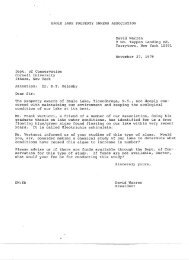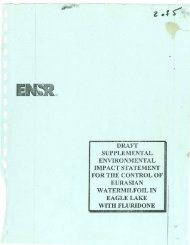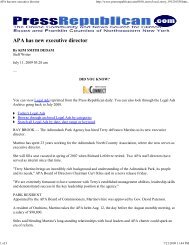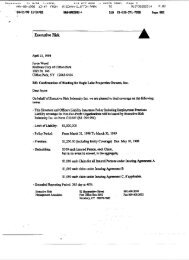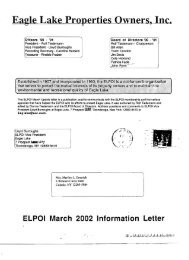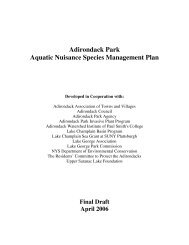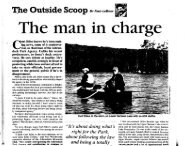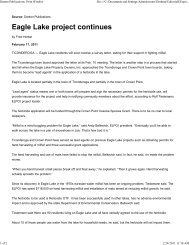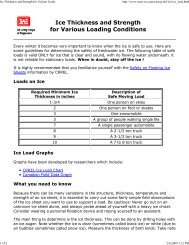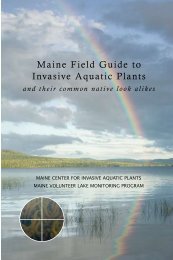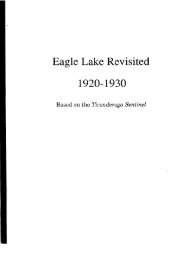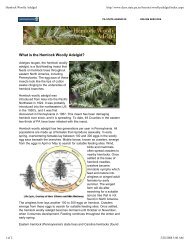2006 Aquatic Plant Monitoring Guidelines
2006 Aquatic Plant Monitoring Guidelines
2006 Aquatic Plant Monitoring Guidelines
Create successful ePaper yourself
Turn your PDF publications into a flip-book with our unique Google optimized e-Paper software.
<strong>2006</strong> <strong>Aquatic</strong> <strong>Plant</strong> <strong>Monitoring</strong> <strong>Guidelines</strong><br />
As part of an enhanced aquatic pesticides review process implemented by the NYSDEC<br />
in 2005, applicants for the use of aquatic pesticides in some lakes may be required to<br />
develop aquatic plant management and monitoring plans. This will allow for a more<br />
consistent evaluation of these applications by NYSDEC permit review staff, and to build<br />
a more complete and defensible record on which to base permit application decisions.<br />
The criteria adopted in <strong>2006</strong> to trigger the development of these plans generally focus on<br />
waterbodies for which the NYSDEC requires an elevated level of protection and concern.<br />
These include waterbodies heavily used by the public for fishing, boating and other<br />
recreational activities, through access provided by New York State; waterbodies used for<br />
potable water; waterbodies in which rare, threatened, or endangered species can be found;<br />
and waterbodies identified by the NYSDEC as a priority for water resource protection<br />
and restoration, through inclusion on the state Priority Waterbody List compiled by the<br />
Division of Water. A master list of waterbodies meeting one or more of these criteria has<br />
been assembled by the NYSDEC and is provided on the NYSDEC’s Division of Solid<br />
and Hazardous Materials website.<br />
Instructions for developing aquatic plant management plans are found on the NYSDEC<br />
Bureau of Water Assessment and Management website as Appendix A of ‘A Primer on<br />
<strong>Aquatic</strong> <strong>Plant</strong> Management in New York State’. A direct link to this web site is<br />
http://www.dec.state.ny.us/website/dow/bwam/aquatic/ch6p4.pdf.<br />
Waterbodies on this list have been assigned standards for developing aquatic plant<br />
monitoring plans, based on a three tiered system. Tier III monitoring guidelines exceed<br />
those identified for Tier II and Tier I waterbodies. Tier II monitoring guidelines closely<br />
resemble those developed for Tier I waterbodies, but have been modified slightly to<br />
address specific concerns.<br />
This document provides instructions for developing an aquatic plant monitoring plan<br />
within the three tiered system. A general summary of the rake toss methodology is<br />
outlined, followed by a short summary of the monitoring guidelines for each tier.<br />
Examples of <strong>Aquatic</strong> <strong>Plant</strong> <strong>Monitoring</strong> forms for each tier are also included in this<br />
document. These guidelines were developed with the assistance of Paul Lord and Robert<br />
Johnson from Cornell University.<br />
For more information about these monitoring guidelines, please contact:<br />
Scott Kishbaugh, P.E.<br />
NYSDEC Division of Water<br />
625 Broadway, 4 th Floor<br />
Albany, NY 12233-3502<br />
518-402-8282 (phone)<br />
518-402-9029 (fax)<br />
sakishba@gw.dec.state.ny.us
Summary of the Rake Toss Methodology<br />
Equipment:<br />
o Two metal rake heads<br />
(handles cut as close to<br />
head as possible) wired<br />
together<br />
o Woven nylon line, at least<br />
40 feet<br />
Sampling Method:<br />
o Go to sample point and<br />
record GPS coordinates on<br />
<strong>Aquatic</strong> <strong>Plant</strong> Sampling form<br />
o Toss rake length of line<br />
o Retrieve rake slowly into<br />
boat<br />
o Estimate overall plant<br />
abundance using Cornell<br />
abundance scale (see<br />
abundance table below)<br />
o Remove plants from rake<br />
tines<br />
o Separate plants into<br />
individual piles<br />
corresponding to individual<br />
plant types (species)<br />
o Tier I: Estimate abundance<br />
of target and exotic species<br />
using Cornell abundance<br />
scale. Estimate abundance of<br />
all other plants (collectively)<br />
using same scale<br />
o Tier III: Estimate %<br />
abundance of all species<br />
using Cornell abundance<br />
scale<br />
o Record plant abundance on<br />
<strong>Aquatic</strong> <strong>Plant</strong> Sampling form<br />
o Make sure all plants are<br />
removed from tines of rake<br />
o Go to next sampling point<br />
and repeat process<br />
Cornell <strong>Plant</strong> Abundance Scale:<br />
Z = zero plants<br />
= no plants on rake<br />
T = trace plants<br />
= fingerful on rake<br />
S = sparse plants<br />
= handful on rake<br />
M = medium plants = rakeful of plants<br />
D = dense plants<br />
= difficult to bring into boat<br />
This methodology was adapted from the U.S. Army Corps of Engineers and further developed by Paul<br />
Lord and Bob Johnson from Cornell University.
Pesticides Program <strong>Monitoring</strong> Requirements<br />
Tier I Lakes<br />
Method:<br />
Frequency:<br />
Number of<br />
Sampling Sites:<br />
Site Locations:<br />
Site Identification:<br />
Site Mapping:<br />
Rake Toss- One Toss Per Site<br />
One Sampling Event Pre-Application (preferably at time when<br />
target plant grows most extensively)<br />
One Sampling Event Post-Application (at time when target plant<br />
grows most extensively)<br />
Lakes < 100 hectares: Larger of 15-50 Sites or 1 Site/hectare of<br />
Littoral Zone (portion of lake less than 10-15 feet deep)<br />
Lakes > 100 hectares: Larger of 30-50 Sites or 1 Site/hectare of<br />
Littoral Zone (portion of lake less than 10-15 feet deep)<br />
Equally Distributed Throughout Littoral Zone (preferably chosen<br />
from 100m x 100m grid overlay on map of lake)<br />
50% of Sites in Treatment Area (spot treatment)<br />
GPS Coordinates, UTM NAD27 Preferred<br />
Sites Labeled on USGS Topographic Maps<br />
<strong>Plant</strong> Identification: Target and Exotic <strong>Plant</strong>s Identified to Species Level<br />
All Other <strong>Plant</strong>s Listed as “Other”<br />
<strong>Plant</strong> Abundance:<br />
Archiving:<br />
Bookkeeping:<br />
Reporting:<br />
Quantified by Cornell/US Army Corps Abundance Scale:<br />
Z = no plants<br />
T = trace plants = fingerful on rake<br />
S = sparse plants = handful on rake<br />
M = medium plants = rakeful of plants<br />
D = dense plants = difficult to bring into boat<br />
Digital photographs of Target and Exotic <strong>Plant</strong>s<br />
<strong>Plant</strong> IDs and Abundance Listing in Table (preferably spreadsheet)<br />
Annual Report- Summary of Methodology and Data Tables<br />
Report Due by December 31 st of Treatment Year
Pesticides Program <strong>Monitoring</strong> Requirements<br />
Tier II Lakes<br />
Method:<br />
1. If Listed for Rare, Threatened, or Endangered Species (RTE):<br />
Rake Toss at Sites > ¼ Mile From Known Location(s) of RTE<br />
Species, One Toss Per Site<br />
Diver Sampling (Swimover or 1 m 2 Transect, Collection of<br />
Single Archive Specimen only) at Sites within ¼ Mile of<br />
Known Location(s) of RTE Species<br />
2. If Listed for Any Other Reason:<br />
Rake Toss- One Toss Per Site<br />
Frequency:<br />
Number of<br />
Sampling Sites:<br />
Site Locations:<br />
One Sampling Event Pre-Application (preferably at time when<br />
target plant grows most extensively)<br />
One Sampling Event Post-Application (at time when target plant<br />
grows most extensively)<br />
Lakes < 100 hectares: Larger of 15-50 Sites or 1 Site/hectare of<br />
Littoral Zone (portion of lake less than 10-15 feet deep)<br />
Lakes > 100 hectares: Larger of 30-50 Sites or 1 Site/hectare of<br />
Littoral Zone (portion of lake less than 10-15 feet deep)<br />
1. If Listed for Rare, Threatened, or Endangered Species (RTE):<br />
At Least 50% of Sites Within ¼ Mile of Known Location(s) of<br />
RTE Species<br />
2. If Listed for Potable Water<br />
At Least 25% of Sites Within ¼ Mile of Known Location(s) of<br />
Major Potable Water Intake(s)<br />
3. If Listed for Any Other Reason<br />
At Least 25% of Sites Within ¼ Mile of Outlet/Connection to<br />
Other Major Waterways<br />
4. If Spot (Partial Lake) Treatment<br />
50% of Sites in Treatment Area (spot treatment)<br />
Additional Conditions:<br />
Sampling Sites Equally Distributed Throughout Littoral Zone<br />
(preferably chosen from 100m x 100m grid overlay on lake map)<br />
Site Identification:<br />
Site Mapping:<br />
GPS Coordinates, UTM NAD27 Preferred<br />
Sampling Sites, Location of Outlet, Potable Water Intakes, and<br />
Location of RTE Species (if known or applicable)<br />
Labeled on USGS Topographic Maps
<strong>Plant</strong> Identification: Target and Exotic <strong>Plant</strong>s Identified to Species Level<br />
All Other <strong>Plant</strong>s Listed as “Other”<br />
Additional Conditions<br />
1. If Listed for Rare, Threatened, or Endangered Species<br />
RTE Identified to Species Level (verification from Natural<br />
Heritage Program or botanist needed)<br />
<strong>Plant</strong> Abundance:<br />
Archiving:<br />
Bookkeeping:<br />
Reporting:<br />
Quantified by Cornell/US Army Corps Abundance Scale:<br />
Z = no plants<br />
T = trace plants = fingerful on rake<br />
S = sparse plants = handful on rake<br />
M = medium plants = rakeful of plants<br />
D = dense plants = difficult to bring into boat<br />
Digital photographs of Target and Exotic <strong>Plant</strong>s, RTE Species<br />
<strong>Plant</strong> IDs and Abundance Listing in Table (preferably spreadsheet)<br />
Annual Report- Summary of Methodology and Data Tables<br />
Report Due by December 31 st of Treatment Year
Pesticides Program <strong>Monitoring</strong> Requirements<br />
Tier III Lakes<br />
Method:<br />
Frequency:<br />
Number of<br />
Sampling Sites:<br />
Site Locations:<br />
Site Identification:<br />
Site Mapping:<br />
Rake Toss- Two Tosses Per Site<br />
One Sampling Event Pre-Application (preferably at time when<br />
target plant grows most extensively)<br />
One Sampling Event Post-Application (at time when target plant<br />
grows most extensively)<br />
Additional Sampling Events Post-Application if Target Species<br />
Not Adequately Controlled or Non-Target Impacts in YOT<br />
Lakes < 100 hectares: Larger of 50 Sites or 1 Site/hectare of<br />
Littoral Zone (portion of lake less than 10-15 feet deep)<br />
Lakes > 100 hectares: Larger of 50-100 Sites or 1 Site/hectare of<br />
Littoral Zone (portion of lake less than 10-15 feet deep)<br />
Equally Distributed Throughout Littoral Zone (chosen from<br />
100m x 100m grid overlay on GIS coverage of lake)<br />
50% of Sites in Treatment Area (spot treatment)<br />
GPS Coordinates, UTM NAD27<br />
Map Generated from Software- ArcView, MapInfo,<br />
DeLorme Xmap/3-D TopoQuads, etc.<br />
<strong>Plant</strong> Identification: Target, Exotic, RTE <strong>Plant</strong>s Identified to Species Level<br />
All Other <strong>Plant</strong>s Identified to Genus Level<br />
<strong>Plant</strong> Abundance:<br />
Archiving:<br />
Bookkeeping:<br />
Reporting:<br />
Percent Abundance of All Species<br />
Overall Abundance Quantified by Cornell/US Army Corps Scale:<br />
Z = no plants<br />
T = trace plants = fingerful on rake<br />
S = sparse plants = handful on rake<br />
M = medium plants = rakeful of plants<br />
D = dense plants = difficult to bring into boat<br />
Digital Photographs of All <strong>Plant</strong>s<br />
Voucher Specimen for Target, Exotic, RTE Species<br />
<strong>Plant</strong> IDs and Abundance Provided in Electronic Spreadsheet/<br />
Database<br />
Annual Report- Summary of Methodology and Data Tables<br />
Report Due by December 31 st of Treatment Year
Example Tier I <strong>Aquatic</strong> <strong>Plant</strong> Survey Form<br />
Lake Name: Start Time: Description Starting Point: Station<br />
Sampling Date: End Time: Lat: Long: Description<br />
Exotics/Target <strong>Plant</strong>s:<br />
Native and Other <strong>Plant</strong>s:<br />
Station#<br />
Sample#<br />
Lat/ NAD27 E<br />
Long/ NAD27 N<br />
Depth (m)<br />
Overall <strong>Plant</strong><br />
Abundance<br />
Eurasian<br />
watermilfoil<br />
water chestnut<br />
curly leafed<br />
pondweed<br />
fanwort<br />
1 1<br />
2 1<br />
3 1<br />
4 1<br />
5 1<br />
6 1<br />
7 1<br />
8 1<br />
9 1<br />
10 1<br />
11 1<br />
12 1<br />
13 1<br />
14 1<br />
15 1<br />
16 1<br />
17 1<br />
18 1<br />
19 1<br />
20 1<br />
Abundance Values: Z = Zero; T = Trace (fingerful); S = Sparse (handful), M = Moderate (rakeful); D = Dense (too much to bring in boat)<br />
Additional Comments:<br />
Other Target:<br />
Other Target:<br />
Other Target:
Example Tier II <strong>Aquatic</strong> <strong>Plant</strong> Survey Form<br />
Lake Name: Start Time: Description Starting Point: Station<br />
Sampling Date: End Time: Lat: Long: Description<br />
Exotics/Target/RTE <strong>Plant</strong>s: Native and Other <strong>Plant</strong>s:<br />
Station#<br />
Sample#<br />
Lat/ NAD27 E<br />
Long/ NAD27 N<br />
Depth (m)<br />
Overall <strong>Plant</strong><br />
Abundance<br />
Eurasian<br />
watermilfoil<br />
water chestnut<br />
curly leafed<br />
pondweed<br />
fanwort<br />
1 1<br />
2 1<br />
3 1<br />
4 1<br />
5 1<br />
6 1<br />
7 1<br />
8 1<br />
9 1<br />
10 1<br />
11 1<br />
12 1<br />
13 1<br />
14 1<br />
15 1<br />
16 1<br />
17 1<br />
18 1<br />
19 1<br />
20 1<br />
Abundance Values: Z = Zero; T = Trace (fingerful); S = Sparse (handful), M = Moderate (rakeful); D = Dense (too much to bring in boat)<br />
Additional Comments:<br />
Other Target:<br />
RTE Species 1:<br />
RTE Species 2:
Example Tier III <strong>Aquatic</strong> <strong>Plant</strong> Survey Form<br />
Lake Name: Start Time: Description Starting Point: Station<br />
Sampling Date: End Time: Lat: Long: Description<br />
Percent Exotics and Target <strong>Plant</strong>s: Percent Native and Other <strong>Plant</strong>s:<br />
Station#<br />
Sample#<br />
Lat/ NAD27 E<br />
Long/ NAD27 N<br />
Depth (m)<br />
Overall <strong>Plant</strong><br />
Abundance<br />
Eurasian<br />
watermilfoil<br />
water chestnut<br />
curly leafed<br />
pondweed<br />
fanwort<br />
1 1<br />
1 2<br />
2 1<br />
2 2<br />
3 1<br />
3 2<br />
4 1<br />
4 2<br />
5 1<br />
5 2<br />
6 1<br />
6 2<br />
7 1<br />
7 2<br />
8 1<br />
8 2<br />
9 1<br />
9 2<br />
10 1<br />
10 2<br />
11 1<br />
11 2<br />
12 1<br />
12 2<br />
Abundance Values: Z = Zero; T = Trace (fingerful); S = Sparse (handful), M = Moderate (rakeful); D = Dense (too much to bring in boat)<br />
Additional Comments:<br />
Other Target:<br />
Other Target:



